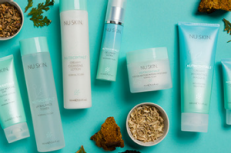How to Manage Adult Acne Effectively | The Source
September 19, 2014
Updated January 2021

Most of us anticipate and accept that acne is part of growing up. As adults, though, we expect to leave pimples, blemishes, and clogged pores in our teenage years. While teenage acne affects more males than females, adult acne is more prevalent in females. Acne can hit adults in their 30s, 40s or even 50s, and as adults it is much more difficult to treat. Have you ever wondered what causes acne? Below are several factors that may contribute to adult acne.
The Root of Clogged Pores
There are four basic changes in the skin that contribute to acne, and they all involve the “pilosebaceous unit” or hair follicle.:
1. Increased sebum production from the sebaceous gland
2. “Hyperkeratinization” or clogging of the duct
3. Increased bacterial activity
4. Inflammation
Since acne presents as different types of lesions (blackheads, whiteheads and inflamed lesions), one or more of the above factors may be involved depending on the resulting change in the skin. Approaches to treatments may also vary according to the type of acne present. For example, Benzoyl peroxide has antibacterial activity, while salicylic acid has antikeratolytic properties, i.e. it helps to unclog pores.
Hormonal Fluctuations Can Cause Breakouts
For many females, acne is due to changes or fluctuations in hormones. This pesky acne often occurs around the mouth area and on the chin. Hormonal fluctuations in women leading to breakouts occur around monthly menstrual cycles, during pregnancy and when going through peri-menopause and menopause. Adult acne in women can also be related to starting or ceasing the use of birth control pills. Hormonal factors can make it increasingly difficult to target both anti-aging appearance concerns and acne concerns simultaneously.
Acne and Stress
Raise your hand if you have ever experienced clogged pores and pimples as a result of stress? Research has identified that stress can instigate acne flare-ups1. Stress triggers the production of corticoid hormones, causing an androgen response in the body. Sebaceous or oil glands are stimulated by androgens, ultimately causing more production of oil or sebum. This snowball effect provides an environment in the skin follicle that supports more bacterial activity, resulting in acne. Unfortunately, not looking our best can add to our stress, resulting in a constant cycle. Be sure to take time to relax to help mitigate this underlying cause!
Skin Sensitivity to Skin Care Products
Many who struggle with acne wonder how to prevent acne and search for good acne products to help get rid of pimples. Some skin products may actually contribute to acne because some ingredients have a greater potential to clog pores. Identifying products that have been tested for comedogenecity and/or acnegenecity may be helpful. Sometimes individuals are simply more sensitive to certain ingredients. By being aware of products that cause sensitivity, individuals may be able to identify patterns or ingredients of personal concern. In some very hot and humid conditions, the use of heavy moisturizers can also contribute to acne breakouts. In contrast, some acne treatments can be very drying to skin. It’s important to do your research and choose products carefully that most appropriately manage your skin condition.
Disadvantage of a “Pore” Diet
Historically, the belief that what we eat influences acne has fluctuated, but recent research has shown that a correlation may exist between acne and high glycemic diets2. This means that eating less sugar and more complex carbohydrates and fiber may help reduce acne breakouts.
The Blemishes of Contact
Another cause of acne and clogged pores could be items coming in contact with our skin. For example, there is a circulating theory that cell phone use can contribute to acne breakouts. Cell phones, especially smart phones, are constantly being touched and handled. This could lead to increased bacteria on the screen, which is then brought up to the face making contact with the cheek. There are some studies in progress to identify “cellular phone dermatitis.” This research discusses dermatitis from cell phones stemming from nickel or chromate allergies4.
Adult Acne Treatment
Acne can be treated with topical treatments. It is important to maintain regular cleansing habits, but topical products provide additional help. The ingredients benzoyl peroxide and salicylic acid have been identified by the U.S. FDA as over the counter (OTC) acne treatments. Benzoyl peroxide as an antimicrobial agent reduces surface bacteria and has bactericidal activity in the sebaceous follicles3, which eliminates the bacteria that causes acne. Salicylic acid is beta hydroxy acid that helps exfoliate the keratinocytes on the outermost layers of the skin, including inside pores and follicles. The lipid solubility of salicylate allows it to penetrate into pores and follicles even when filled with sebum5. Helping cell turnover and breaking up sebum plugs help to keep pores clear, eliminating the environment needed to produce acne. An additional benefit of salicylic acid for adult acne is that it has anti-aging properties due to improvements in cell turnover.
One of Nu Skin’s OTC acne treatments, Nutricentials Here You Glow Exfoliating Toner, utilizes the pore clearing benefits of Salicylic acid mentioned above. This toner does more than just tone. It penetrates deeply into pores to clean and treat acne by dissolving pore-blocking dirt, oil, and debris. Its thoughtfully balanced formula helps clear up acne blemishes and blackheads while helping prevent new breakouts for clearer, cleaner skin. Your skin is left looking clean, clear, and radiant.
Unfortunately, adult acne can be tough to treat and OTC formulations may not work for some individuals. In this case, seeking the assistance of a dermatologist may be helpful.
Written By: Helen Knaggs

References
1. A Chiu, SY Chon, AB Kimball. The Response of Skin Disease to Stress: Changes in the Severity of Acne Vulgaris as Affected by Examination Stress. Arch Dematol/Vol 139, July 2003; p 897-900.
2. J Burris, W Rietkerk, K Woolf. Acne: The Role of Medical Nutrition Therapy. Journal of the Academy of Nutrition and Dietetics,Volume 113/Issue 3 (March 2013); p 416-430.
3. DR Berk, SJ Bayliss. Cellular Phone and Cellular Phone Accessory Dermatitis Due to Nickel Allergy: Report of Five Cases. Pediatric Dermatology, Vol 28/Issue 3 (May/Jun 2011); p 327-331.
4. Bojar RA, Cunliffe WJ, Holland KT. The short-term treatment of acne vulgaris with benzyl peroxide: effects on the surface and follicular cutaneous microflora. Br. J. Dermatol. 132, 204–208 (1995).
You Might Also Like:
-
When our skin looks good, we feel good and have more confidence. That’s why people are always on the hunt for the best products, treatments, and technology. The goal is radiant, youthful-looking, fresh-faced, and glowing skin. Luckily, it’s getting easier than ever to attain.
-
Bioadaptive botanicals, also known as adaptogens, are the big buzz in modern skin care. Why? As the name suggests, they’re plants that adapt to their natural environments. Basically, bio = environment, and adaptive = able to adjust to changing conditions. While it sounds pretty straightforward, there’s a bit more to it than meets the eye.

